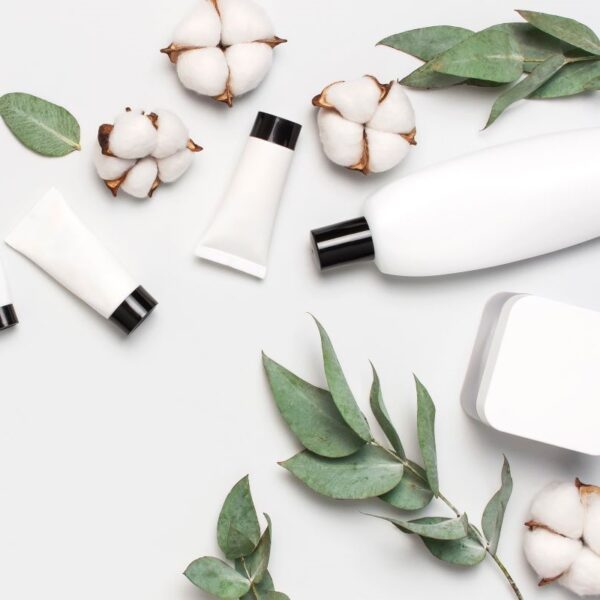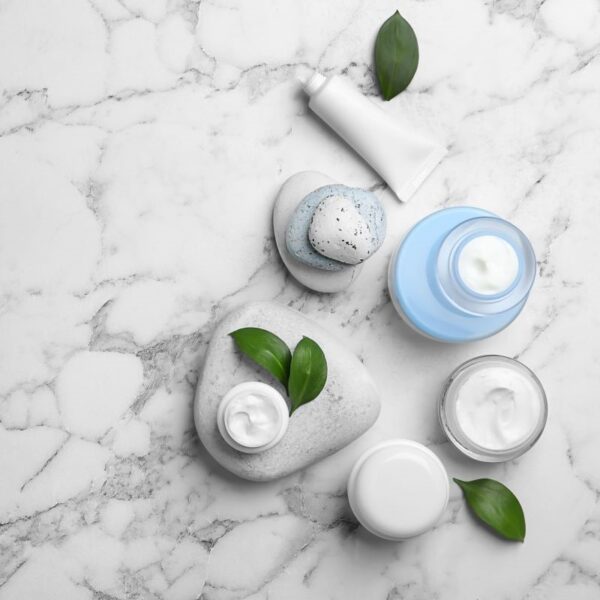Silicones have become an integral part of the beauty industry, where most products have “silicone” present. Their use in formulations for numerous cosmetic and personal care categories and the synergistic effects obtained with other components have made them a popular ingredient amongst the formulators.
One widely utilized type of silicone in the personal care industry is cyclopentasiloxane (D5). It offers a range of benefits given its unique properties, including skin and hair softening, spreadability, and volatility, which makes it a preferred ingredient in many cosmetic and personal care formulations, such as deodorants, hair sprays, skin care creams, and color cosmetics.
What is Cyclopentasiloxane?
Decamethylcyclopentasiloxane, also known as D5, is an organosilicon compound with the formula [(CH₃)₂SiO]₅. It is a colorless and odorless liquid that is slightly volatile. The compound is classified as cyclomethicone. Commercially D5 is produced from dimethyldichlorosilane. Hydrolysis of the dichloride produces a mixture of cyclic dimethyl siloxanes and polydimethylsiloxane. The cyclic siloxanes, including D5, can be removed from this mixture by distillation. In the presence of a strong base such as KOH, the polymer/ring mixture is equilibrated, allowing complete conversion to the more volatile cyclic siloxanes.
Source: Wikipedia
Use of Cyclopentasiloxane in Personal Care Products
A few key, unusual functional attributes make silicone a “must-have” in a personal care formulation. These include:
- Silicones have better surface tension reduction than that obtained with organic surfactants and, at much lower concentrations, as well as the capability of foaming associative films upon dry-down.
- Given the presence of the silicone moiety, these materials have expanded emulsification properties beyond those of the organic surfactants.
- They also have foaming ability in both aqueous and nonaqueous environments.
- The capability to disperse pigments
- An ability to generate a desirable, unusual sensory/aesthetic silky feel.
The cyclopentasiloxane compound is commonly used in cosmetic products to provide a solvent that feels dry on the skin. Key areas where this family of materials is used include antiperspirants, color cosmetics, and as a base solvent to blend with fragrance and perfume oils. These are commonly used in cosmetics, such as deodorants, sunblocks, hair sprays, and skin care products. It is becoming more common in hair conditioners, as it makes the hair easier to brush without breakage. It is also used as part of silicone-based personal lubricants. D5 is also considered an emollient.
Applications in Personal Care
The cyclic silicones have a dry feel when applied to the skin for two main reasons. First, they can lower the surface tension of the formulation, containing oil and thereby leading to a drier-feeling product since they are surface active in oils. Second, since the cyclics are so volatile, they evaporate rapidly when exposed to the skin’s temperature. There are several cosmetic applications in which a dry skin feel is essential. These include antiperspirants, skin serums, and sun-care products. It protects the hair from the elements, keeping it smooth and shiny. Dry and damaged hair feels healthy by filling in the porosity and providing nourishing conditioning benefits. With improved compatibility on wet and dry hair and anti-static property with less build-up effect, it is a good choice for hair shampoo, rinse-off conditioner, and leave-in treatment. In short, silicones can play significant roles in shampoos, conditioners, colorants, or styling products.
Cyclopentasiloxane is used in a variety of products. From a commercial view, most importantly, they have been used in antiperspirant formulations because they:
- Impart a soft-silky feel to the skin
- Provide excellent spreading
- Leave no oily residue or buildup
- De-tackify formulations
- Are non-greasy
- Are compatible with a wide range of cosmetic ingredients
- Lower surface tension and
- Provide transient emollience on the skin.
Here are some of the common functions and applications of cyclopentasiloxane:
| Function | Applications |
| Emollient | Cyclopentasiloxane serves as a non-comedogenic emollient for skin care formulations. The hydrating properties of cyclopentasiloxane are excellent for the skin as it traps moisture, making the skin smooth and soft. It is used in lightweight products as it does not penetrate the skin but evaporates quickly. |
| Color Protection | Cyclopentasiloxane can help colored hair last longer, retain its vibrant look, and protect and enhance color and shine. Rinse-off conditioners containing different types of cyclopentasiloxane can show an increase in color retention for hair that has been colored. |
| Heat Protectant | Protecting hair from excessive heat is a need among many consumers. Hair dryers and other heated appliances first soften the keratin of the hair. If the devices are too hot, they can cause water in the hair to boil, forming minute bubbles of steam inside the softened hair shaft, weakening the fiber and potentially leading to total fracture. Cyclopentasiloxane is thermally stable and spreads easily on the hair, forming a protective film to help prevent water loss from the hair shaft caused by the heat of dryers or heated styling tools. Thus help guard against damage from heat styling. |
| Carrier and Perfume Deliver | Cyclopentasiloxane serves as a prominent carrier for many skin care and hair care formulations. While being a carrier it also helps deliver fragrance and gives skin a smooth, non-cooling feel. It also acts as a transient carrier for active salts in antiperspirants & deodorants. |
| Hair Conditioning | Cyclopentasiloxanes are recognized as multifunctional ingredients in a variety of hair care products. With their unique chemical and physical properties, these highly versatile materials not only condition hair but can be used to add shine, making combing easier. Both are suitable for dry combing results and wet combing. It also enhances hair strength, repairs damaged hair, gives a perception of moisturization, aids curl retention, controls frizz, and adds volume—or even reduces volume. It is commonly used in shampoos, hair conditioners, hair sprays, anti-frizz, and hair-detangling products. It forms a layer on the hair, protecting and preventing it from damage while also allowing the product to spread easily and evenly. |
Product Examples
Cyclopentasiloxane is used in many products, including:
| Type | Examples |
| Bath & Shower Products | Bath Oils, Bath Shower, Foaming shower gels |
| Hair Products | Hair Sprays, Hair gels, Hair styling aids, Shampoos, Conditioners |
| Skin Care Range | Cleansing Creams, Skin creams, lotions, Stick Products, Body lotions, Body oils, Shaving Products |
| AP/Deodorants | Deodorants |
| Color Cosmetics | Makeup products, Foundation, Mascara, Nail Polish, Primer, Lipsticks |
| Sun Care Products | Suntan creams, Sunscreens, Sunblocks, Sunless tanning lotion |
Properties of Cyclopentasiloxane
| Chemical Name | Decamethylcyclopentasiloxane |
| Chemical Formula | [(CH₃)₂SiO]₅ |
| Appearance at 25 °C | Colorless liquid |
| Viscosity (cSt) | 3.50 – 4.50 |
| Molecular Weight (g/ml) | 371 |
| Specific Gravity (at 25°C/15.6°C) | 0.950 – 0.960 |
| Density at 18°C (g/cm3) | 0.96 |
| Acid Value (mg KOH/g) | max. 0.0100 |
| Solubility in Water at 25°C | 17-20 µg/L |
| Melting Point at 760 mmHg (°C) | −47 °C |
| Boiling Point (at 760 mmHg) | 211°C |
| Flash Point (°C) | 77 |
| Refractive Index | 1.397 |
| Heat of Vaporization (at 25°C) kJ/kg | 157 kJ/kg |
| Odor | Odorless |
| Shelf Life | 12-18 months |
| Storage Conditions | – Product should be stored at or below 5°C (9°F) in original, unopened containers. – When handling volatile fluids at temperatures 10°C below the quoted flash point, care should be taken. – As with any flammable material, containers should be kept tightly closed and away from heat, sparks, flames, and other ignition sources. |
Typical Formulations
Matte Longwear Lipstick – Radiant Orchid
The design and advantages of this formulation can brighten your smile with cool, playful lipstick. This formula goes on creamy matte, covers perfectly, and stays put for hours. Combining Kester Wax K-82H and Enhans PC38 provides excellent structure while keeping the stick creamy. Enhans SC-78 allows the incorporation of silicone into the formula without the risk of blooming and feels silky on the lips.
| Phase | INCI Name | Trade Name | % Wt. |
| A | Synthetic Beeswax | Kester Wax K-82H | 13.00 |
| Copernicia Cerifera (Carnauba) Wax (and)Stearoxy Dimethicone | Enhans SC-78 | 5.00 | |
| Polyethylene, HydrogenatedCyclopentadiene, Stearoxy Dimethicone | Enhans PC-38 | 4.00 | |
| C18-38 Alkyl Hydroxystearoyl Stearate | Kester Wax K-82P | 3.00 | |
| Octyldodecyl Stearoyl Stearate | Ceraphyl 847 | 23.00 | |
| Polybutene | Indopol H-100 | 2.00 | |
| B | Lauryl Laurate | Kester Wax K-24 | 11.28 |
| Trimethylsiloxyphenyl Dimethicone | Belsil PDM 20 | 3.76 | |
| Red 28 Lake CI 45410 | Unipure Red LC 328 | 2.00 | |
| Red 28 Lake CI 73360 | Unipure Red LC 300 | 1.76 | |
| Iron Oxides CI 77491 | Unipure Red LC 386 | 1.60 | |
| Ultramarines CI 77007 | Unipure Blue LC 686 | 0.20 | |
| Mica Sericite BC 285 | Mica | 11.80 | |
| Titanium Dioxide CI 77891 | Titanium Dioxide 325 | 7.60 | |
| C | Cyclopentasiloxane | Jeesilc CPS-211 | 10.00 |
| Total | 100.0 | ||
Formulation Procedure
Procedure:
- Combine Phase B/Color Base ingredients and mix and mill until homogeneous, heating slightly if needed.
- Combine Phase A ingredients and melt until uniform.
- Add Phase B to A while maintaining a liquid state, ensuring pigments are well dispersed.
- Add Phase C and mix.
- Pour into molds at 85 °C quickly to avoid loss.
Formulation Results
Stability: Three months at 45 °C, one month at high RH, three freeze/thaw cycles.
Source: Knowde
Cyclopentasiloxane Formulation Considerations
| Recommended Usage Level | Recommended Usage Level 1-5% (Hair Care) 0.5-3% (Perfumes) 3-10% (Antiperspirants, Deodorants) 2-10% (Skin Care) |
| Compatible with | Compatible with Waxes like beeswax, Paraffin wax, Myristyl myristate, hydrocarbons like paraffin, petrolatum, esters, and other silicones. |
| Incompatible with | Castor oil. It must be used with other surfactants to solubilize and incorporate into the water-based formulations. |
Safety & Regulatory Concerns
FDA Information
The US Food and Drug Administration has approved the safety of cyclopentasiloxane (D5).
EU Information
The SCCS considers that using cyclopentasiloxane (D5) in cosmetic products is safe at the reported concentrations, except for use in hair styling aerosols and sun care spray products. Indeed, for these products, at the maximal concentrations declared by the applicant and based on the hypothesis retained by SCCS, exposure to D5 may lead to air concentrations above the value where SCCS considered that D5 might be aerosolized and locally toxic. Exposure to D5 from hair styling spray products also triggers high levels of aggregate exposure, which may also lead to concentrations in the air, the value considered safe by the SCCS. This opinion does not cover the use of D5 in oral care products.
Cosmetic Ingredient Review (CIR)
The CIR Expert Panel concluded that cyclopentasiloxane is safe as cosmetic ingredients in the practices of use and concentration as tested in the safety assessment.
Identification Numbers
| CAS Number | 541-02-6 |
| EC Number | 208-764-9 |
Acceptable Limits and Maximum Usage
The maximum usage level of cyclopentasiloxane (D5) in the personal care industry is as follows:
| Product Categories | End-uses in the SCCS Notes of Guidance | Max concentration (%) |
| Bathing, Showering | Shower gel | 5 |
| Hand wash soap, bath oil, salts etc | 0 | |
| Body scrub (wash-off) | 12 | |
| Chemical exfoliation products (rinse-off) | 2 | |
| Hair Care | Shampoo | 5 |
| Hair conditioner | 64 | |
| Hair styling | 90 | |
| Hair styling aerosol (pressurized) pump | 1 | |
| Hair styling cosmetic pump spray | 70 | |
| Hair treatment | 69 | |
| Skin Care | Body lotion | 92 |
| Body oil | 60 | |
| Products for tanning without sun | 30 | |
| Face cream | 93 | |
| Hand cream | 83 | |
| Foot care products | 18 | |
| Makeup Products | Liquid foundation | 85 |
| Concealer | 33 | |
| Eye concealer | 89 | |
| Face powder | 1 | |
| Mascara | 40 | |
| Eyeliner | 51 | |
| Sun Care | Sunscreen lotion/cream | 44 |
| Nail Care | Nail polish | 2 |
| Nail care products (leave-on) | 76 | |
| Nail treatment | 25 | |
| Hand wash soap, bath oil, salts, etc | 85 | |
| Cuticle cream | 5 |
Source: Europa.eu (Page-53-54)
Health Effects of Cyclopentasiloxane
- Skin irritation and sensitization: According to old non-GLP studies, D5 appears mildly irritant to the skin or mucous membranes. The test substance is considered to have a slight eye irritation potential. According to OECD guidelines, a GLP study demonstrated that D5 is not a skin sensitizer. Overall, SCCS concluded that D5 is mildly irritant to the skin and eye and does not cause any skin sensitization.
- Skin reactions after induction exposures: No signs of erythema or edema were observed in the test or control animals throughout the induction scoring phase. Cyclopentasiloxane is not an active sensitizer.
- The SCCS believes D5 does not risk human health when used in cosmetic products. Other uses of D5 were not considered in this risk assessment.
Cyclopentasiloxane Safety & Toxicity
- The dangers to the environment of these substances were raised in April 2015 by the United Kingdom, which had submitted a dossier to the European Chemicals Agency (ECHA) proposing the restriction of both D4 and D5 in cosmetic products that are washed off in normal conditions of use.
- Consequently, the European Commission restricted silicones octamethylcyclotetrasiloxane (D4) and decamethylcyclopentasiloxane (D5) in wash-off personal care products this past January 2020.
- Per Regulation (EU) 2018/35, wash-off cosmetic products must not contain a concentration of D5 higher than 0.1%. According to the document, this limit “effectively ensures that all intentional use of D5 will cease since those substances must be present in wash-off cosmetic products in a much higher concentration to perform their intended function.”
- The European Commission classifies D5 as persistent, bioaccumulative, and toxic (PBT) very persistent and very bioaccumulative (VPvB) substances, respectively.
- Notably, the new restriction applies only to wash-off products— D5 eventually evaporates from products intended for prolonged contact with the skin or hair and poses a lesser environmental risk. In contrast, the ingredients enter the water supply before evaporating from wash-off products.
- Applicable products containing either ingredient in a concentration higher than 0.1% will not be allowed on the European market after Jan 31, 2020. All the wash-off products with higher % should be reformulated.
- The restriction will only apply to wash-off cosmetic products that, under normal conditions of use, are removed with water shortly after application because, in these circumstances, D5 is emitted to the aquatic environment before evaporation. Moreover, it is pointed out that economic operators should be allowed sufficient time to take appropriate measures to comply with the restriction. The new restriction will, therefore, only apply as of Jan 31, 2020.
- The restriction is incorporated into the REACH Regulation’s Annex XVII. This Annex contains the list of restricted hazardous substances, mixtures, and articles on the EU market. The relevant provisions state that D5 shall not be placed on the market in wash-off cosmetic products in a concentration equal to or greater than 0.1% by weight of either substance after Jan 31, 2020.
Fun Facts About Cyclopentasiloxane
- One might not typically connect skincare products with the beach, but cyclopentasiloxane actually originates from silica, the primary component of sand.
- The reason why many skin and hair products make your skin feel silky smooth or your hair glossy is often due to cyclopentasiloxane. It’s known for its lubricating properties, creating a smooth, velvety feel.
- Impressive Heat Stability: Cyclopentasiloxane has a high heat resistance, making it a popular choice for heat protectant hair products. It creates a protective barrier on the hair shaft, preventing damage from styling tools.
Additional Resources
- ScienceDirect – Antistatic Agent
- European Commission – SCCS Opinion on Cyclopentasiloxane
- Dow – The Beauty of Silicone in Hair Care Application
- The Good Scents Company – Cyclopentasiloxane
- Kremer Pigmente – Cyclopentasiloxane
- UK Government – Safety Data Sheet: Cyclopentasiloxane
- SAGE Journals – Potential of Cyclopentasiloxane to Cause Female Infertility
- COSlaw – Watch Out: Cyclopentasiloxane
- SagePub – Safety Assessment of Cyclomethicone






